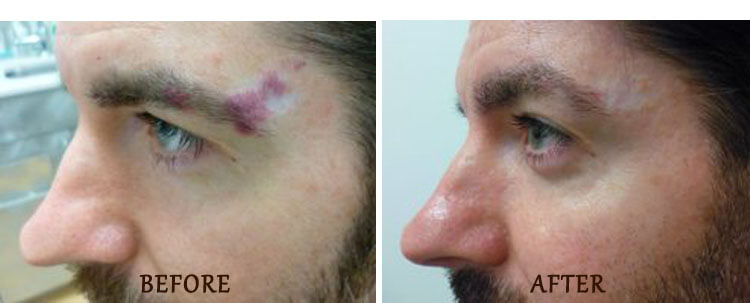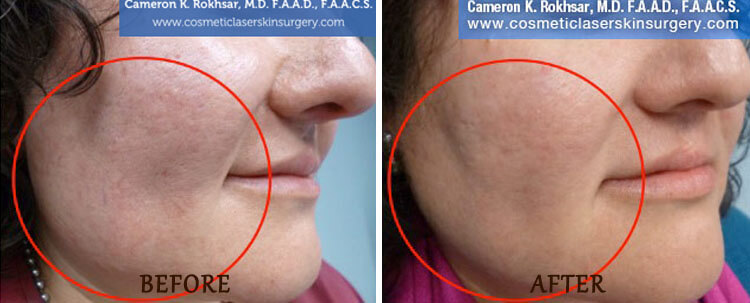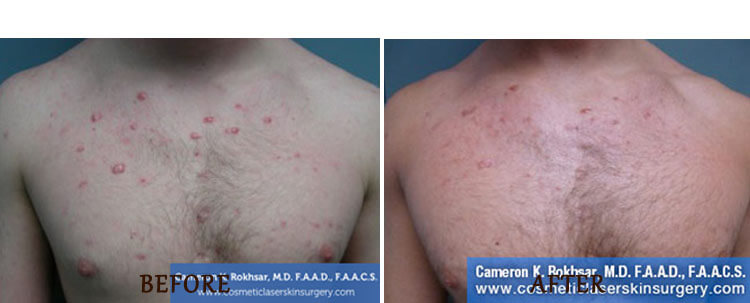Broken Capillaries Laser Treatment in New York
Get a Smoother, More Even Skin Tone
Broken blood vessels are fine, red veins that commonly appear on the nose, chin or cheeks, but can also appear in other parts of the body. They have also been referred to as varicose or spider veins, They usually appear as a result of aging, pregnancy, childbirth, birth control pills, sun damage, or Rosacea. Broken blood vessels are fine, red veins that usually form on the nose, chin or cheeks as a result of skin damage, causing the blood vessels just beneath the surface to crack. The bulging appearance is a result of a clot that forms within the blood vessels, making it bulge from added pressure. As the blood passes by the clot, stress gradually increases on the vessels and it eventually weakens and breaks. These small, red blood vessels can be easily removed with lasers, which target the hemoglobin (blood) that is present in the vessels. The visible blood vessels are targeted and removed. They absorb the light emitted from the laser and destroys the vessel without damaging the surrounding skin or any non-targeted vessels.
The most effective treatment is the V-Beam pulsed dye laser. The procedure usually takes a few minutes and does not require numbing cream because it is equipped with a cooling spray to soothe the skin. Most patients usually need 1-3 treatments, depending on the size of the veins. The concentrated laser targets individual veins, which turns into heat and forces the body to absorb the veins, leaving behind clearer skin. Dr. Rokhsar will advise the patient to apply moisturizer or sunscreen to protect the skin and speed up the healing process. Temporary discoloration, crusting, bruising, blistering or redness may occur but lasts only a few days.
Dr. Rokhsar provides patients with the V-Beam Perfecta laser, the most advanced version of the V-Beam laser. This laser is highly effective for treating blood vessels and vascular lesions. Depending on the severity of the patient’s broken blood vessels, multiple treatments may be required.
Get Your Broken Capillaries Treatment Today
There’s no reason to let uneven skin tone or broken capillaries keep you down. Redness and unevenness in the skin are not permanent. Dr. Rokhsar provides a wide variety of treatments designed to help even out skin tone and give patients a more natural look. In other words, just because you have broken capillaries or redness of the skin, that doesn’t mean those issues can’t be addressed. Dr. Rokhsar is one of the world’s leading experts on laser systems and cosmetic laser technologies, so he’s an excellent resource to help you.
V-Beam: Before and After
*Results may vary.
Most of our patients who have gone through treatment note a substantial increase in confidence and self-esteem. If you want to see what Dr. Rokhsar can do for you, contact our office to schedule a no-pressure consultation and get the process started!
Broken Capillaries FAQs
What does a broken blood vessel look like?
Broken blood vessels or capillaries on the face look like a network of tiny red lines that interconnect. Patients with broken capillaries often suffer from rosacea. These patients also blush and flush commonly. With repeated bouts of blushing and flushing, the facial blood vessels remain dilated, and broken capillaries become more apparent on the face which translates into a red face. Some patients with broken capillaries complain of burning and itchiness on the face as well.
What causes broken capillaries on the face?
One of the most common causes is sun exposure, which can cause overexpansion of the capillaries and make them more prone to breaking. Trauma to the skin, such as from windburn or extreme temperature changes, can also lead to broken capillaries. Excessive alcohol consumption, which can cause blood vessels to enlarge and break, is another possible cause.
Other potential causes include genetic factors, which may make some people more prone to broken capillaries, and medications that thin the blood. Picking at or popping pimples can also cause broken capillaries, as can certain medical conditions such as rosacea. Finally, prolonged straining from activities such as coughing, vomiting, or giving birth can cause tiny broken blood vessels known as petechiae on the face, neck, and chest.
What causes broken capillaries on legs?
Broken capillaries on legs can be caused by a variety of factors. One of the most common causes is prolonged standing, which can put pressure on the capillaries and cause them to burst. Most people with broken capillaries on the legs have floppy valves in the larger vein. These valves prevent the backflow of blood in our veins. When these valves are faulty or floppy due to genetics, the extra pressure in the venous system causes veins to dilate which ultimately results in new capillary or small blood vessel formation. Medical conditions such as capillaritis and Schamberg disease can also cause broken capillaries on the legs. Other contributing factors include obesity, smoking, and alcohol consumption, which can all lead to increased pressure on the veins and capillaries. In addition, injury and circulatory disorders can also contribute to the development of broken capillaries in the legs. Sclerotherapy remains the option to get rid of broken capillaries on the legs. Vascular lasers remain another option.
How to treat broken capillaries on the face?
Here are some effective treatments for broken capillaries on the face:
- Laser therapy: Pulsed dye lasers or IPL (intense pulsed light) can be used to target the broken blood vessels and destroy them. These treatments are safe and effective, but they may require multiple sessions. Dr. Rokhsar prefers to use the Vbeam laser which precisely targets vascular lesions and safely removes them.
- Radiofrequency: This non-invasive treatment uses radiofrequency energy to heat and destroy the broken capillaries, and it can also stimulate collagen production to improve the skin’s texture and tone.
- The pulse dye laser (Vbeam) laser remains the best option as it selectively heats up the broken capillaries to destroy them. One to 3 sessions of Vbeam laser are often required.
Prevention is the best strategy for broken capillaries. Protecting your skin from the sun, avoiding hot water and harsh facial products, and using gentle, soothing ingredients can all help to prevent broken capillaries from forming in the first place. We recommend you consult with Dr. Cameron Rokhsar, a double-board-certified Dermatologist and Dermatologic Surgeon and an expert in laser therapies, to determine the best treatment plan for your specific needs.
New York Office Locations
Upper East Side Manhattan Office
121 East 60th Street, Suite 8AB New York, NY 10022
(212) 285-1110
Long Island Office
901 Stewart Ave, Suite 240, Garden City, NY 11530
(516) 512-7616








 Dr. Rokhsar was chosen by
Dr. Rokhsar was chosen by 






